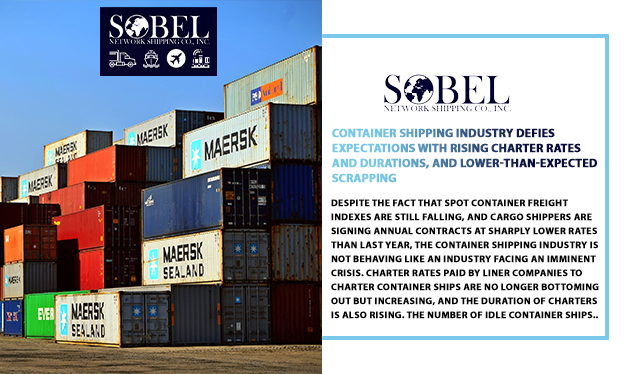Despite the fact that spot container freight indexes are still falling, and cargo shippers are signing annual contracts at sharply lower rates than last year, the container shipping industry is not behaving like an industry facing an imminent crisis. Charter rates paid by liner companies to charter container ships are no longer bottoming out but increasing, and the duration of charters is also rising. The number of idle container ships has decreased in recent weeks, and liner companies continue to buy more vessels in the secondhand market. The expected tsunami of ship recycling has yet to occur, and the number of older ships demolished year-to-date is lower than expected. Container lines continue to place orders at shipyards for more vessels, despite the fact that the container ship orderbook reached an all-time high in terms of TEUs scheduled for delivery.
The Harpex index, which measures global charter rates, has been inching back upward since early March. According to Maritime Strategies International (MSI), spot freight rates are still eroding, while “in contrast, charter markets not only found a floor but also recorded slight upticks across different vessel size categories.” MSI said the “disconnect between the spot freight and the charter markets continued to widen in recent weeks.” The nonoperating owners (NOOs) – the companies that charter ships to ocean carriers – “seem to have the edge over liner operators at this point, as demand for vessels remains firm and supply tight,” added MSI. Charter rates are now rising markedly for all ship sizes, according to Alphaliner, and demand is strong across the board.
Charter durations were extending out to three to five years at the peak of the container shipping boom. By early this year, they had contracted back to six months. Now, they’re increasing again. “A 12-month period is becoming the new normal,” said brokerage Braemar. Some deals are now being done for two years or more. Commercially idle capacity has fallen back in recent weeks. Analysts expect the onslaught of newbuildings, together with continued weak transit demand, will lead to more commercially inactive ships as owners and operators temporarily idle their tonnage.
Scrapping year-to-date has been at nowhere near the pace needed to reach projections. Only liners have sent ships for demolition in 2023 up until today. “In contrast, NOOs see no incentive to scrap even their oldest ships yet, so long as charter rates remain firmly above their pre-pandemic levels.” It’s not just the charter market that’s keeping container ships from the breakers; it’s also the S&P market. Both carriers and NOOs have gone into the cyclical downturn with huge cash reserves amassed during the boom, which will cushion the fallout from excess ship capacity.
Overall, the container shipping industry does not appear to be battening down the hatches for a looming storm, despite mixed signals in the market. There are several categories of buyers in the S&P market, including the larger liner companies. The ordering of new ships continues, driven by demand for dual-fuel vessels, with fresh orders not ceasing in the wake of plunging freight rates. Both carriers and NOOs are well-prepared, with deep backlogs and strong balance sheets. While downturns in cyclical industries, and definitely in shipping, usually come unexpectedly, this time, companies in the sector are very strong financially, which gives a better outlook for container shipping than people might think if they just look at freight rates and the orderbook.


